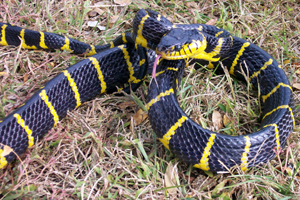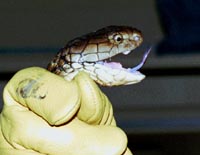
KINI R MANJUNATHA
Emeritus Professor
Contact Information:
Department of Biological Sciences
National University of Singapore
14 Science Drive 4
Singapore 117543
Lab: Prof Kini’s Lab
6516 5235
6779 2486
dbskinim@nus.edu.sg
News
Toxic snake venom to fight human disease

A research team, led by Professor RM Kini, discovers the first species-specific toxin.
Read more at: Virginia Commonwealth News
Research Areas
Protein chemistry, Structure-function relationships, Protein-protein interaction and Protein design and engineering.
Research Interests
The overall objective is to understand structure-function relationships of proteins, particularly snake venom toxins, and their mechanism. Snake venoms are rich sources of toxins that interfere with various physiological processes. We are specifically interested in protein families of phospholipase A2 (PLA2) enzymes, serine proteinases, three-finger toxins and helveprins. The functional diversity despite the structural similarity and the presence of functional sites in different segments of the toxins makes our research interesting and challenging. The functional sites are used in designing proteins with novel biological activities and prototypes of therapeutic agents.
Current projects
Snake venom proteins that affect thrombosis and hemostasis
Several toxins interfere in blood coagulation and platelet aggregation. We study the structure-function relationships and mechanism of anticoagulant and antiplatelet proteins, particularly PLA2 enzymes. The strongly anticoagulant PLA2 binds to factor Xa and specifically inhibits the prothrombinase complex. Based on the anticoagulant site of PLA2, we are attempting to identify the functional sites of coagulation factors. We also determine the structure of venom prothrombin activators that are structural and functional homologs of coagulation factors. Based on their structures, we are designing anticoagulant peptides.
Design and development of bioactive peptides
We have identified anticoagulant, antiplatelet and hypotensive sites in snake venom toxins. We are currently designing more potent and stable short peptides. We also plan to develop proteins with novel functions using these functional sites. We also design of short peptides with specific structural folds.
Purification and characterization of novel toxins
We isolate and characterize novel toxins that are found in the venoms in small quantities. We have isolated and characterized several novel toxins. We continue to isolate and identify structurally and/or functionally unique toxins from venomous animals.
Research accomplishments
-
Shown structural features in the flanking segments of protein-protein interaction sites.
-
Determined structure-function relationships and mechanism of PLA2 enzymes.
-
identified common cytolytic region in proteins.
-
Identified the structure-function relationships of three-finger toxins and solved the mechanism of antiplatelet effects of cardiotoxins.
-
Determined structure of prothrombin activators and designed anticoagulant peptides.

23 Patent applications, over 110 research publications and 2 books.
Book: Venom Phospholipase A2 Enzymes: Structure, Function and Mechanism (Kini, R.M., Editor), Pg. 1-511, John Wiley & Sons, Chichester, England, 1997.
